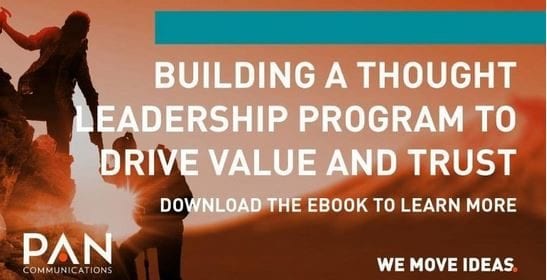Public relations professional turned- journalist, Lisa Morgan, has covered the enterprise tech and IT industry for some time now. Coming from the PR side, Lisa understands what it’s like to pitch reporters and work alongside PR pros to come up with a story that works.
Lisa has worked with PAN employees and clients for a few years now and is incredibly insightful and inquisitive when it comes to her reporting style and coverage for publications like InformationWeek, SD Times, TechTarget and more. She “gets” the enterprise tech side of business and asks questions that are both curious and interesting.
Check out Lisa’s recent Q&A with PAN to learn about how she began a career in journalism and how she recommends PR pros approach journalists.

What sparked your interest in journalism?
I call myself “the accidental journalist” because I became a journalist by default. I had been working on the PR side, running groups at agencies and heading up worldwide PR, advertising, and partnerships for a very large event producer. As I was leaving the last job to start my own business, it was blatantly obvious to me that e-commerce was going to be The Next Big Thing for the Internet.
At the time, it was just a collection of online brochures. Sales was obviously next. And, I was literally working with the people who started the Internet (ARPAnet) and invented email, etc. I knew every EIC that mattered in the Internet/computing space. No one believed what I was saying about ecommerce. However, the EIC of Internet World took pity on me and said he’d pay me to write a story about it. When the article hit, I got two offers to write book chapters from publishers and chaired an Internet conference in Tokyo and Nagoya for university professors and senior executives of large Japanese firms (Sony, Hitachi, Panasonic, etc.). I’ve been writing for industry publications ever since. Before that, I was executive ghostwriting for many years.
What type of stories are ideal for your beat?
I don’t really have a “beat” per se. It depends on the publication. I am often tapped for expertise in AI ethics, AI, machine learning, data analytics, data science, enterprise software, IoT, emerging technologies, software development, business strategy, IT strategy, and related legal issues (since I hold a JD). I think issues and trends make more interesting stories than what’s contained in most press releases.
What’s the worst and best pitch you’ve ever received?
I’ll tell you the characteristics of each. The best types of pitches are those that understand what they’re talking about in the first place and target a journalist who actually covers it. The worst are ones that target people with a pulse, or pitch clients on their resume. Just about everybody who is pitched to me has an impressive resume. That does not mean they’re experts in the areas I cover. Sadly, most people don’t take the time to understand what expertise their clients do and don’t have specifically.
What are some of your PR pet peeves?
- Blanket, untargeted pitches. First, most of them are irrelevant. Second, they blast something to who knows how many people and then expect individual responses.
- No real knowledge of what they’re pitching whether it’s people, products, services, or companies.

- No knowledge of what the reporter or editor actually covers. While Christmas toys are fun, I don’t cover them.
- I’ve politely said no, and now the person wants to keep the conversation going.
- I’ve said “yes” to something and now the person thinks we’re best friends. As a best friend, I’m therefore interested in everything they send, not realizing most of it is irrelevant.
- USE OF CAPS. PEOPLE USE THEM TO STAND OUT. IT’S MAKING AN IMPRESSION, BUT NOT THE ONE THEY THINK.
- Weekend pitches. They’re using those to stand out and congratulations! They’re making an impression, but not the one they desire.
- Starting a subject line with “Interview Opportunity:” Every PR contact is an interview opportunity. Journalists laugh among themselves about this one.
- Press releases sent as is.
- People who try to change the direction of stories. This is also an agency tactic. However, I have to pitch some stories I write, others are assigned. The angle is the angle, and if the interview veers off in another direction that’s more in line with what the client wants, I’ll try to correct it. Sometimes that correction has meant the client confessed s/he didn’t really know anything about the topic at hand. Everyone’s time was wasted, and everyone was embarrassed.
- Very short pitches that are essentially a collection of links. I’m not going to take the time to research all of this. Tell me what you want me to know.
- Links to videos. My pet peeve with video is it’s linear, so I can’t jump to what might be relevant. I categorically will not watch a video included in a pitch.
Is there anything you would like PR professionals to know about pitching, following up, etc.?
- Make a point of understanding what you’re pitching. Many PR people don’t feel it’s their job to know. While the client is obviously the expert, know a little bit more so you can at least answer simple questions. This was one thing that used to bug me at the agencies I worked at, too.
- Don’t use PR databases as a substitute for thinking. People do that all the time. They don’t take the time to understand the people they’re pitching to, and quite frankly the PR databases suck when it comes to categorizing stuff (which is why agencies sometimes ask me to ID actual targets).
- Think before you pitch. I write pitches for agencies behind the scenes sometimes because I understand the material. To do that, I may need to do some research to get up to speed with the issue. For example, I just did a collection of pitches about B-Corps based on a big industry announcement. Most people don’t take the time to do that. It makes a huge difference when you come across as someone who’s savvy about the issues.
- Summarize a press release. Tell reporters what’s significant about it, briefly, and then include the release in the email, not as an attachment.
- Avoid sending unnecessary attachments.
- Think you’re in sales? When I ask this in agency presentations that I give, quite often no one raises their hand. You’re in the business of selling ideas, which is why it’s important to learn the art of sales and to understand the “product” (idea) you’re selling.
- Following up is a best practice. Most people don’t do it. It often doesn’t change the outcome, but sometimes it does.
- I can feel your pain. First, being on your side of the desk (on behalf of agencies and corporate clients) and the other side of the desk simultaneously, I can “hear” peoples’ pain in the pitches I get and in the follow-up messages. Sometimes I write back with words of encouragement, even if I can’t cover what’s being pitched because I know they’re trying.
- Don’t be afraid to ask for access to the technical guys (and I recommend you do it). Pop the hood. Make a point of understanding your client’s business, and products or services. The marketing people always focus on the positive stuff. The technical guys will give you the real story – good and bad. If you understand the fuller picture, when a reporter or journalist throws you a curveball, you’re not blindsided by it. Also, you have that deeper knowledge about the client that I was discussing earlier.
- If you’re pitching something as “new,” make sure it is. Seasoned journalists have seen many generations of tech and know what’s new and what isn’t. If you don’t know, you come across as green.
- The opposite of all the other stuff I mentioned under “pet peeves.”



